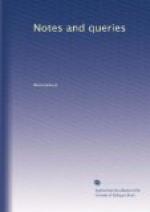D. ROCK
Fiz-gig (Vol. ii, p. 120).—I had expected that your Querist C.B. would have received an {238} immediate reply to his Query as to the meaning of fiz-gig, because the word is in Johnson’s Dictionary, where he may also see the line from Sandys’ Job, in which it caught his attention.
You may as well, therefore, tell him two things,—that fiz-gig means a fish-cart and that Querists should abstain from soliciting your aid in all cases where a common dictionary would give them the information they want.
H.W.
Guineas (Vol. ii., p. 10.).—The coin named in the document quoted by A.J.H. is the Guiennois a gold piece struck at Guienne by Edward III., and also by his son the Black Prince. It is not likely that the Guiennois was the original of the name given to the new gold coin of Charles II., because it could have had no claim to preference beyond the Mouton, the Chaise, the Pavillon, or any other old Anglo-Gallic coin. I think we may rest contented with the statement of Leake (who wrote not much more than half a century after the event), and who says that the Guinea was so called from the gold of which it was made having been brought from Guinea by the African Company, whose stamp of an elephant was ordered to be impressed upon it.
J.C. Witton.
Numismatics.—My thanks are due to Mr. J.C. Witton (Vol. ii., p. 42.) for his replies to my Numismatic Queries, though I cannot coincide with his opinion on Nos. 1. and 3.
No ancient forger would have taken the pains to cut a die to strike lead from; and my specimen, from its sharpness, has clearly never been in circulation: why may it not have been a proof from the original die?
Of No. 2. I have since been shown several specimens, which had before, I suppose, escaped my notice.
On the coin of Macrinus, the letter below the S.C. now clearly appears to be an [Greek: eta], but the one above is not a [Greek: Delta], but rather an L or inverted T. It cannot stand for [Greek: Lykabas], as on the Egyptian coinage, as Macrinus was slain by his soldiers the year after his accession.
The Etruscilla, even under a powerful magnifier, betrays no trace of ever having been plated and has all the marks by which numismatists determine the genuineness of a coin. The absence of S.C., I must remind Mr. W., is not uncommon on third brass, though of course it always appears on the first and second.
I need go no farther than the one just mentioned of Tiberius, which has no S.C., and I possess several others which are deficient in this particular, a Severus Alexander, Elagabalus, &c. After Gallienus it never appears.
E.S.T.




